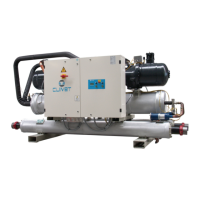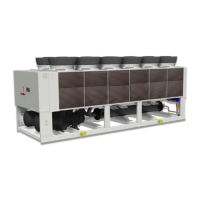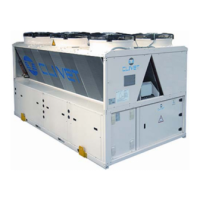Do you have a question about the CLIVET WDAT-3 2.160 and is the answer not in the manual?
Covers manual purpose, instructions, expert use, local safety, power, packaging, maintenance, faults, repairs, modifications, intended use, additional safety, data updates.
Details compressors, structure, internal/external exchangers, fans, and refrigerant circuits.
Describes electrical panel components, accessories, and factory testing procedures.
Details various versions, temperature ranges, energy savings, acoustic, and efficiency configurations.
Explains the company's quality system and commitment to improvement.
Details the EC directives and legislation the products comply with.
Describes participation in the Eurovent certification for chillers.
Lists common risks, defines danger areas, and covers handling and installation risks.
Details risks related to electrical, moving parts, refrigerants, and water systems.
Provides safety charts and first-aid measures for refrigerants.
Covers manipulation, storage, exposure control, physical/chemical properties, stability, and toxicological info.
Presents electrical data, weights, and operating limits for various unit configurations and sizes.
Details exchanger pressure drop, fouling correction, and antifreeze solution factors.
Lists calibration points for safety devices and controls.
Provides sound level data and operating limits for heat exchangers.
Instructions for checking the unit for damage and completeness upon delivery.
Guidelines for storing the unit to maintain its integrity.
Details safe handling operations, including lifting points.
Instructions for safely removing packaging and checking for damage.
Factors to consider for installing air-conditioning systems, including technical spaces and connections.
Explains the need for specific spaces around the unit for operation and maintenance.
Provides instructions for installing the unit in its final fixed position outdoors.
Details the installation of anti-vibration devices and the selection of mounts.
Presents detailed dimensions and weight distribution for various unit configurations and sizes.
Guidelines for designing water piping, including bends, head variations, and intercepting valves.
Specific instructions for connecting the evaporator, including filter, flow switch, and antifreeze solutions.
Describes the correct method for connecting using Victaulic joints to avoid damage.
Explains the Hydropack accessory for flow capacity and head, including its features and benefits.
Describes the function and requirements of the optional heat recovery exchanger.
Provides FLA, LRA, FLI, and MIC values for standard configurations and sizes.
Presents electrical data for LN and EN acoustic configurations.
Step-by-step instructions for connecting the unit to the main power supply.
Details remote control options, signaling, set-point adjustments, and probe inputs.
Describes the composition and function of various modules within the CLIVET TALK system.
Explains remote keyboard operation and Modbus/CAN converters.
Describes the Master/Slave network setup for connecting multiple units.
Covers initial checks for power, refrigerant, water, and electrical systems before starting.
Specific instructions for using crankcase heaters before compressor startup.
Verifies tensions, absorptions, remote inputs, set-points, water flow, refrigerant circuit, and reduced load operation.
Describes the main control panel interface, operating modes, and startup procedure.
Explains how to set the cooling point and use compensations for energy efficiency.
Details maintenance set-point, second set-point, demand limit, timetables, and parameter access.
Lists available parameters and explains how to use the keypad for setup.
Guides on how to use the keypad to navigate parameter and scheduling setup menus.
Instructions for setting the clock and understanding unit status information.
Lists and explains general status parameters and module-specific status data.
Explains alarm causes, reset procedures, and how to view/store alarms.
Explains the importance of maintenance for unit efficiency and longevity.
Details specific maintenance tasks for air coils, structure, and fans.
Outlines the frequency and scope of inspections by authorized personnel.
Covers putting the unit at rest and definitions for refrigerant data.
Provides pressure and temperature data for various refrigerants (R-22, R-134a, R-407C, R-410A).
Guides on diagnosing and resolving issues with broken probes and pressure transducers.
Lists potential causes and checks for high and low pressure alarms.
Covers troubleshooting steps for compressor and fan protection alarms.
Instructions for safely disconnecting the unit, including refrigerant and antifreeze recovery.
Procedures for sending the unit to authorized centers for dismantling and disposal.
Covers manual purpose, instructions, expert use, local safety, power, packaging, maintenance, faults, repairs, modifications, intended use, additional safety, data updates.
Details compressors, structure, internal/external exchangers, fans, and refrigerant circuits.
Describes electrical panel components, accessories, and factory testing procedures.
Details various versions, temperature ranges, energy savings, acoustic, and efficiency configurations.
Explains the company's quality system and commitment to improvement.
Details the EC directives and legislation the products comply with.
Describes participation in the Eurovent certification for chillers.
Lists common risks, defines danger areas, and covers handling and installation risks.
Details risks related to electrical, moving parts, refrigerants, and water systems.
Provides safety charts and first-aid measures for refrigerants.
Covers manipulation, storage, exposure control, physical/chemical properties, stability, and toxicological info.
Presents electrical data, weights, and operating limits for various unit configurations and sizes.
Details exchanger pressure drop, fouling correction, and antifreeze solution factors.
Lists calibration points for safety devices and controls.
Provides sound level data and operating limits for heat exchangers.
Instructions for checking the unit for damage and completeness upon delivery.
Guidelines for storing the unit to maintain its integrity.
Details safe handling operations, including lifting points.
Instructions for safely removing packaging and checking for damage.
Factors to consider for installing air-conditioning systems, including technical spaces and connections.
Explains the need for specific spaces around the unit for operation and maintenance.
Provides instructions for installing the unit in its final fixed position outdoors.
Details the installation of anti-vibration devices and the selection of mounts.
Presents detailed dimensions and weight distribution for various unit configurations and sizes.
Guidelines for designing water piping, including bends, head variations, and intercepting valves.
Specific instructions for connecting the evaporator, including filter, flow switch, and antifreeze solutions.
Describes the correct method for connecting using Victaulic joints to avoid damage.
Explains the Hydropack accessory for flow capacity and head, including its features and benefits.
Describes the function and requirements of the optional heat recovery exchanger.
Provides FLA, LRA, FLI, and MIC values for standard configurations and sizes.
Presents electrical data for LN and EN acoustic configurations.
Step-by-step instructions for connecting the unit to the main power supply.
Details remote control options, signaling, set-point adjustments, and probe inputs.
Describes the composition and function of various modules within the CLIVET TALK system.
Explains remote keyboard operation and Modbus/CAN converters.
Describes the Master/Slave network setup for connecting multiple units.
Covers initial checks for power, refrigerant, water, and electrical systems before starting.
Specific instructions for using crankcase heaters before compressor startup.
Verifies tensions, absorptions, remote inputs, set-points, water flow, refrigerant circuit, and reduced load operation.
Describes the main control panel interface, operating modes, and startup procedure.
Explains how to set the cooling point and use compensations for energy efficiency.
Details maintenance set-point, second set-point, demand limit, timetables, and parameter access.
Lists available parameters and explains how to use the keypad for setup.
Guides on how to use the keypad to navigate parameter and scheduling setup menus.
Instructions for setting the clock and understanding unit status information.
Lists and explains general status parameters and module-specific status data.
Explains alarm causes, reset procedures, and how to view/store alarms.
Explains the importance of maintenance for unit efficiency and longevity.
Details specific maintenance tasks for air coils, structure, and fans.
Outlines the frequency and scope of inspections by authorized personnel.
Covers putting the unit at rest and definitions for refrigerant data.
Provides pressure and temperature data for various refrigerants (R-22, R-134a, R-407C, R-410A).
Guides on diagnosing and resolving issues with broken probes and pressure transducers.
Lists potential causes and checks for high and low pressure alarms.
Covers troubleshooting steps for compressor and fan protection alarms.
Instructions for safely disconnecting the unit, including refrigerant and antifreeze recovery.
Procedures for sending the unit to authorized centers for dismantling and disposal.












